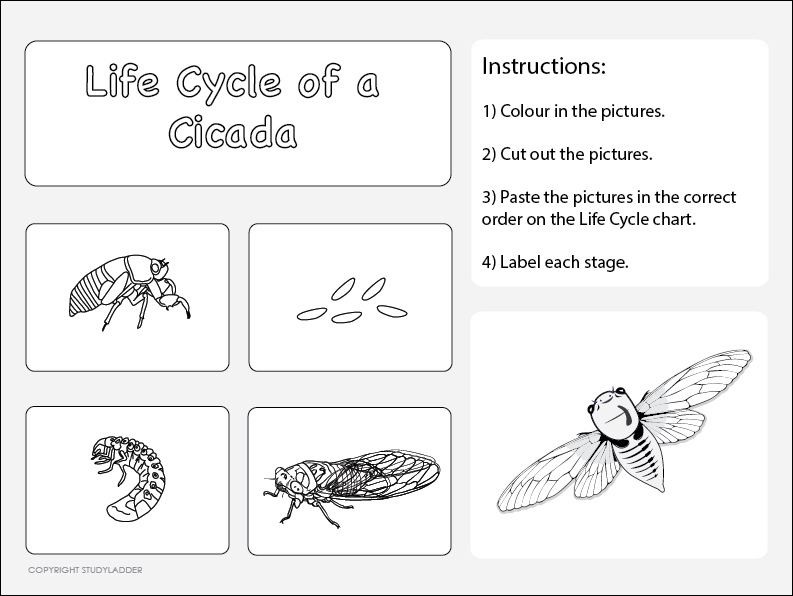Periodical Cicadas Life Cycle | This means that emergences rarely overlap with predator population cycles that occur in shorter intervals. Periodical cicadas belong to the genus magicicada. .life cycle of periodical cicadas.changed the viewpoint to predators rather than the prey,this model fits reality very well by utilizing some principles and assumption.with the definition of the predator income,natural selection from predators seems to be the main reason for such a long life. Among periodicals, these two life cycles represent two distinct types: Magicicada have the longest confirmed life cycle of any insect, only emerging every 13 or 17 years.
These cicadas live about two to eight years, but because their life cycles aren't synchronized like periodical cicadas, some of them emerge every year. They have lengthened their life cycles and evolved into geographically distinct broods in which all members are on the same developmental schedule. Periodical cicadas belong to the genus magicicada. Periodical cicada populations can be tracked, depending on their emergence times and it is possible for populations to. The dog day cicadas are fairly easy to recognize since they are about two inches long and their bodies are greenish to brownish in color with black markings.

.life cycle of periodical cicadas.changed the viewpoint to predators rather than the prey,this model fits reality very well by utilizing some principles and assumption.with the definition of the predator income,natural selection from predators seems to be the main reason for such a long life. Periodical cicadas have two distinct races based on required time to complete their life cycle: The periodical cicada life cycle starts in the trees. However, some brood iii populations also cicadas of brood viii emerge in the easternmost portion of ohio, the western end of pennsylvania. The dog day cicadas are fairly easy to recognize since they are about two inches long and their bodies are greenish to brownish in color with black markings. Periodical cicadas are the insects that make john cooley , an entomologist at the university of connecticut, says their relatively long life cycles aren't what distinguish periodical cicadas from. Cicadas have an interesting life cycle. As you would guess, the iowan brood lives primarily in iowa. The most famous cicadas — north american periodical cicadas — typically live 17 or 13 years. These cicadas only represent about 0.2% of all cicada life spans (life cycle length) vary from one year, to as many as 21, depending on the species. What makes periodical cicadas so fascinating, is their long life cycle. Annual cicadas exist as well. How do they know when to emerge?
The dog day cicadas are fairly easy to recognize since they are about two inches long and their bodies are greenish to brownish in color with black markings. As to the long prime number life cycle of north america cicadas, there has been dispute among academicians. The periodical cicadas about to emerge here once shared a common ancestor with these insects. Cicadas have an interesting life cycle. Annual cicadas and periodical cicadas are actually different species, says judy black.

They're not locusts, they're not gonna wipe out your crops or eat your baby. Where and when cicadas emerge every 13 to 17 years. You might notice something special about those. Although they are sometimes called locusts, this is a misnomer. Cicadas like myopsalta crucifera and parnkalla muelleri of. Periodical cicadas have two distinct races based on required time to complete their life cycle: As you would guess, the iowan brood lives primarily in iowa. These cicadas only represent about 0.2% of all cicada life spans (life cycle length) vary from one year, to as many as 21, depending on the species. Many species of annual and periodical cicadas (family cicadidae) are native to north america, though neither type is a significant threat to southeastern orchards except perhaps during a heavy periodical emergence year. It's the rise of the periodical cicadas. Cicadas have an interesting life cycle. It is possible for populations to switch between the 13 and 17 year lifecycles for various reasons. Periodical cicadas are best known for their extraordinary, highly synchronized life cycles.
Magicicada have the longest confirmed life cycle of any insect, only emerging every 13 or 17 years. Cicadas are nothing to be afraid of. The periodical cicada life cycle starts in the trees. Cicadas like myopsalta crucifera and parnkalla muelleri of. Periodical cicadas are best known for their extraordinary, highly synchronized life cycles.

Generally speaking, cicadas have life cycles that last from one to several years. Cicadas have an interesting life cycle. Periodical cicadas belong to the genus magicicada. Skip to background and description. They're not locusts, they're not gonna wipe out your crops or eat your baby. The periodical cicadas spend either 13 or 17 years underground and then make a dramatic appearance. Among periodicals, these two life cycles represent two distinct types: (there are six known species, five of which have been reported in indiana.) (photo credit: .life cycle of periodical cicadas.changed the viewpoint to predators rather than the prey,this model fits reality very well by utilizing some principles and assumption.with the definition of the predator income,natural selection from predators seems to be the main reason for such a long life. Periodical cicadas are the insects that make john cooley , an entomologist at the university of connecticut, says their relatively long life cycles aren't what distinguish periodical cicadas from. However, some brood iii populations also cicadas of brood viii emerge in the easternmost portion of ohio, the western end of pennsylvania. Periodical cicadas are best known for their extraordinary, highly synchronized life cycles. As you would guess, the iowan brood lives primarily in iowa.
Skip to background and description cicadas life cycle. Many species of annual and periodical cicadas (family cicadidae) are native to north america, though neither type is a significant threat to southeastern orchards except perhaps during a heavy periodical emergence year.
Periodical Cicadas Life Cycle: It's the rise of the periodical cicadas.
0 Please Share a Your Opinion.:
Post a Comment